
Erdös
|

Knuth
|

Rota
|

Wilf
|

Shannon
|

Pollak
|

Graham
|
When I first started watercolors, I painted mainly seascapes around my favorite spots
at La Jolla and Vancouver.
A couple years ago, I began to experiment portraits of people who I care about.
Soon I ran out of subjects within the family. Then I discovered a
gold mine ---- my mathematical friends.
I am fortunate to have known many mathematicians.
Here I will focus on those who have influenced my mathematics, mostly
teachers, mentors and coauthors.
This is an ambitious project that might take a very long time to tussle with.
Bear in mind that portraits are not photos. Human eyes are mercilessly critical
so that
doing portrait is an invitation to frustration. The painting is only meant to
reveal
some or any aspect of the person.
In addition, the scanned pictures can not fully capture the
richness of the original paintings,
hindered further by different settings of various browsers.
Paul Erdös
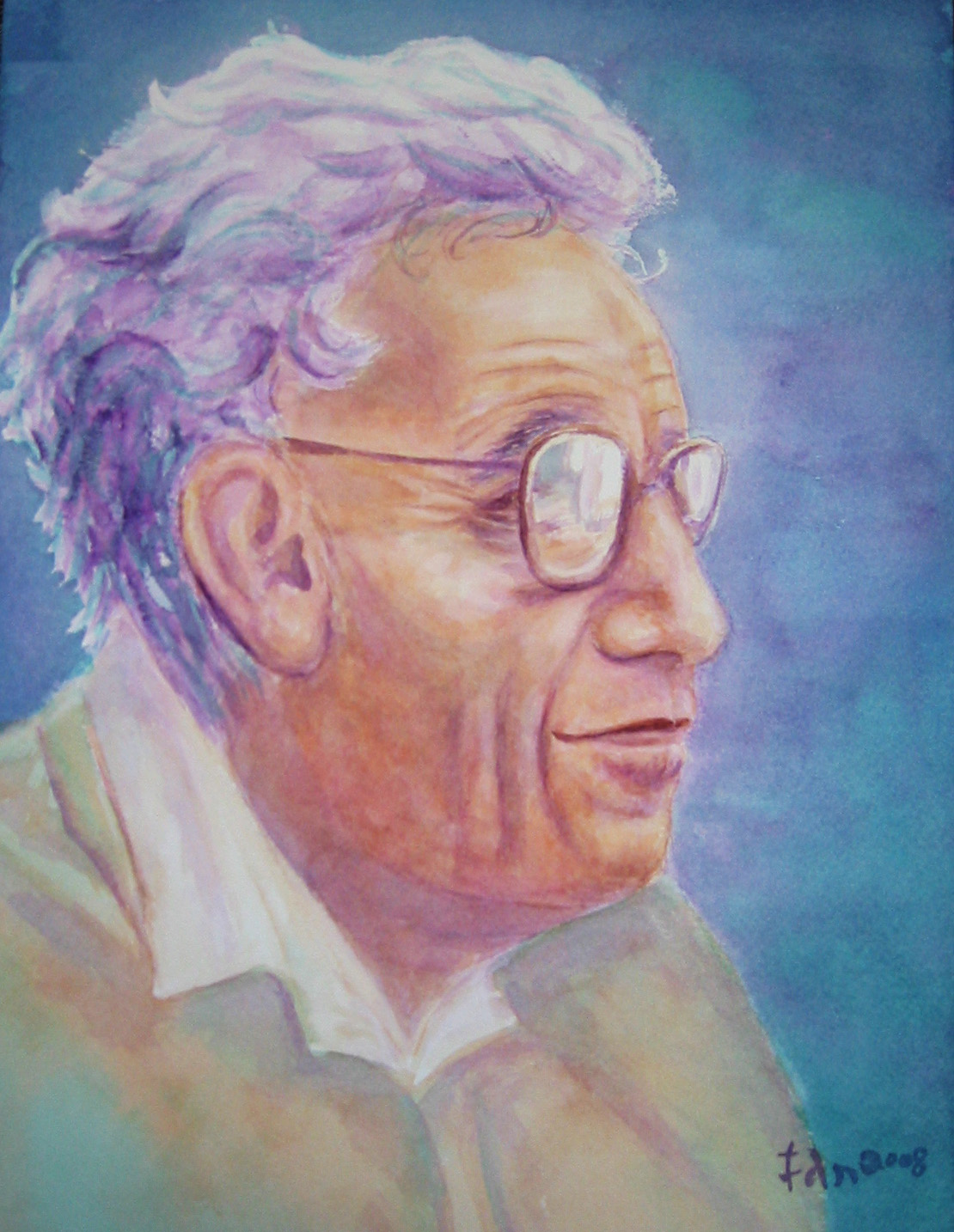
"Prove and conjecture"
A portrait of Paul Erdös
(July 16, 2008)
|
There is no question that Erdös
had greatly influenced my
research.
When I was at Bell Labs, once every year I was supposed to write a
"I-am-great" report.
I noticed one year that more than half of my work (six out of
eleven) were connected to Erdös, either as coauther or as the problem source.
During the many visits of Paul, he loved to mention problems, his own or those
he heard.
We have
fourteen joint papers so my Erdös number is 1 or 1/14, depending
on how you count. One of our main joint projects is on "
unavoidable graphs",
finding the largest unavoidable structure in a graph (or hypergraphs) with
given edge density. I still have a big folder containing many unsolved
problems in this direction.
Erdös often gave prize money for his problems that had been
around and tested by good people.
For three times,
I solved his problems with money. The first time is that I broke his lower bound
on the number of different distances among n points in the plane (from
n2/3 to n5/7).
The second time is on integer sets containing no solution to x+y=3z (joint with John Goldwasser). The third time is
on a counter example about
bandwidth.
Paul often added money when his problem remained unsolved for a while.
When he got older, he became more generous because he was impatient.
I was lucky to see him often and caught his problems when he was old
and the problems were still "young".
Paul is great at formulating problems,
nailing down the essence in its simplest
form that might be barely within reach.
He left such a big hole when he passed away in 1997.
Here is a remembrance that I wrote about Paul.
|
Don Knuth
|
|

The master of perfection
A portrait of Don Knuth
(August 16, 2008)
|
I thought that I was a perfectionist until I met Knuth. To display math
equations right, Big Don spent TEN years inventing Tex, which we, mathematicians,
all use today.
A while ago, he asked me for a vita. He re-Tex the whole thing with comments
much longer than the document that I sent him. I was very honored to be asked
in connection with some unsuccesful attempt of establishing
a center at Stanford.
Knuth's great influence is through his books. "The Art of Computer Programming"
has been widely regarded as the
bible of the area. Reading
Concrete Mathematics is like a treasure hunt.
I once gave an introduction for his plenary talk at SODA
by plotting a time table
of his more than 20 books. Although volume 4 of The Art of Computer Programming
is slow in coming, he has been constantly writing books after books at an
amazing speed. No one can focus with greater concentration than
Big Don.
Recently, I returned to one of my favorite subjects --- classical combinatorial identities --- in connection with juggling patterns and bubble-sort algorithms.
Ron and I proved an intriguing new identity concerning Eulerian numbers.
After Ron told Don about this identity and our hope for an bijection proof,
Don actually took an exception
subcombing to the attraction of Eulerian numbers.
During a flight to England, he figured out a highly nontrivial bijection proof.
As a result, we have a joint paper which will be his last paper and my
first joint paper with him.
I vividly remember one advice that Knuth gave:
"If you can write one good page
a day, it is a great day."
|
Gian-Carlo Rota
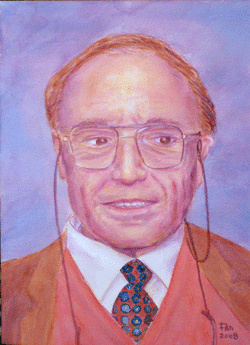
The indiscrete thinker,
A portrait of Gian-Carlo Rota
(November 15, 2008)
|
If Herb Wilf, my thesis advisor, hadn't had heard a fateful lecture of Rota,
he wouldn't have completely changed the direction of his research.
If I hadn't had run into Herb, I would have
missed all the fun in combinatorics.
Lateron I learnt that
my colleague Andriano Garsia is another one of such converts.
So, you see, Rota's influence in combinatorics is all over the places.
Rota's work on Möbius function reads like a poem.
He wrote so elegancely.
His book ``Indiscrete Thought" is a pleasure to read.
In fact, various passages there seem to perhaps touch the distant part
of our soul.
Here are links to an
interview of Rota and
the
ten lessens that Rota wished he had been taught.
|
Herbert Wilf
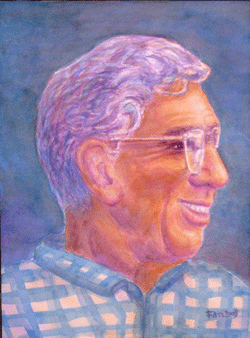
The most wonderful teacher
A portrait of Herbert Wilf
(November 20, 2008)
|
When I first went to the graduate school at U Penn, I thought I might specialize
in number theory or algebra.
It is my great fortune to have run into
Herb and found combinatorics. From Herb,
I saw, for the first time, mathematics in action --- not just to read the books
and do the exercises but to put theorems in use to create new mathematics.
Herb gave me really good problems --- those I always seem to be able to make
some progress upon.
The lectures that Herb gave were magical.
I still remember
the beautiful lectures on network flows from his class.
There is no doubt in my mind that Herb is the most wonderful teacher in the whole wild world.
At his 65th birthday, we had quite a party at Penn. Here are links to a
tribute
that I worte with Joan Hutchinson. There was a
special volume and
many photos.
Herb wrote many books, most of which are available for download. He started two main journals, Journal
of Algorithms in 1980 with Don Knuth, and The electronic Journal of Combinatorics.
|
Claude Shannon
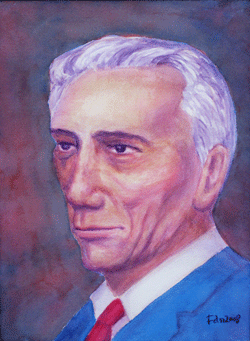
A true genius
A portrait of Claude Shannon
(December 3, 2008)
|
Shannon was a legend, especially from the stories that I heard
at Bell Labs.
When I first met Shannon, he had retired from mathematics, living not too far
from
Boston.
During our many visits, he eagerly showed Ron and me his new toys, especially
juggling machines. He invented
a
large varieties of unicycles, including a unicyle for
two, a unicycle with no pedel and a unicycle with square tires (so the rocking position stays horizontally
constant).
Shannon was the founding father of information theory. His papers
are purely ingenius.
Shannon's collected papers
is a treasure.
However, Shannon scarcely published after he left Bell labs in 1956 and
retired early,
almost 45 years before he passed away in 2001.
The popular story was that Shannon became very wealthy by successfully using
the connection of information
theory and game theory. His quiting research was a consequence of being too rich.
During our visits, of course we tried to find out
what really happened. Was there a magical formula for investing
?
Well, what I found is quite different from the great story
about the legend.
Shannon's real investment strategy is to hold good stocks for a long time,
not the Las Vegas
version of instant return!
|
Henry Pollak
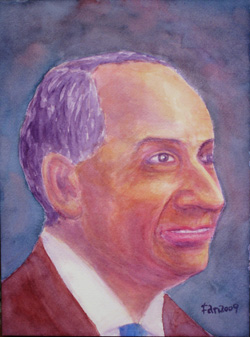
A great educator
A portrait of Henry Pollak
(January 2, 2009)
|
When I first joined Bell Labs, it was intimidating just to walk in the hallway
seeing name tags of famous people around. By extending your arm in the long corridor,
it was likly to catch an interesting problem or
some flow of ideas.
Henry was the big director with an office at the end of the corridor,
very distant from mine.
Soon I found out that Henry read carefully
every paper we wrote before the paper was released for publication.
He was extremely helpful in identifying all the embarrassing typos.
What he was really good at
is
to suggest new connections and further applications.
His encouragements and enthusiastism has great influenced upon
my research.
After a few years at the Labs I was no longer afraid of him. One day we
sat next to each other at the cafeteria. I recalled that we talked about
various difficulties in writing research
papers. I told him that, inspite of numerous typos that he found in my writing,
I had in fact spent a great deal of my time and efforts
and, in particular, I rewrote my first paper at the Labs eight times.
Then Henry told me that his first paper was rewritten 24 times!
Henry has been very actively in activities of MAA, serving as the President among other
work. Here are two good links about him:
Solving
problems in real world
and
A conversation with Henry
Pollak.
|
Ronald Graham
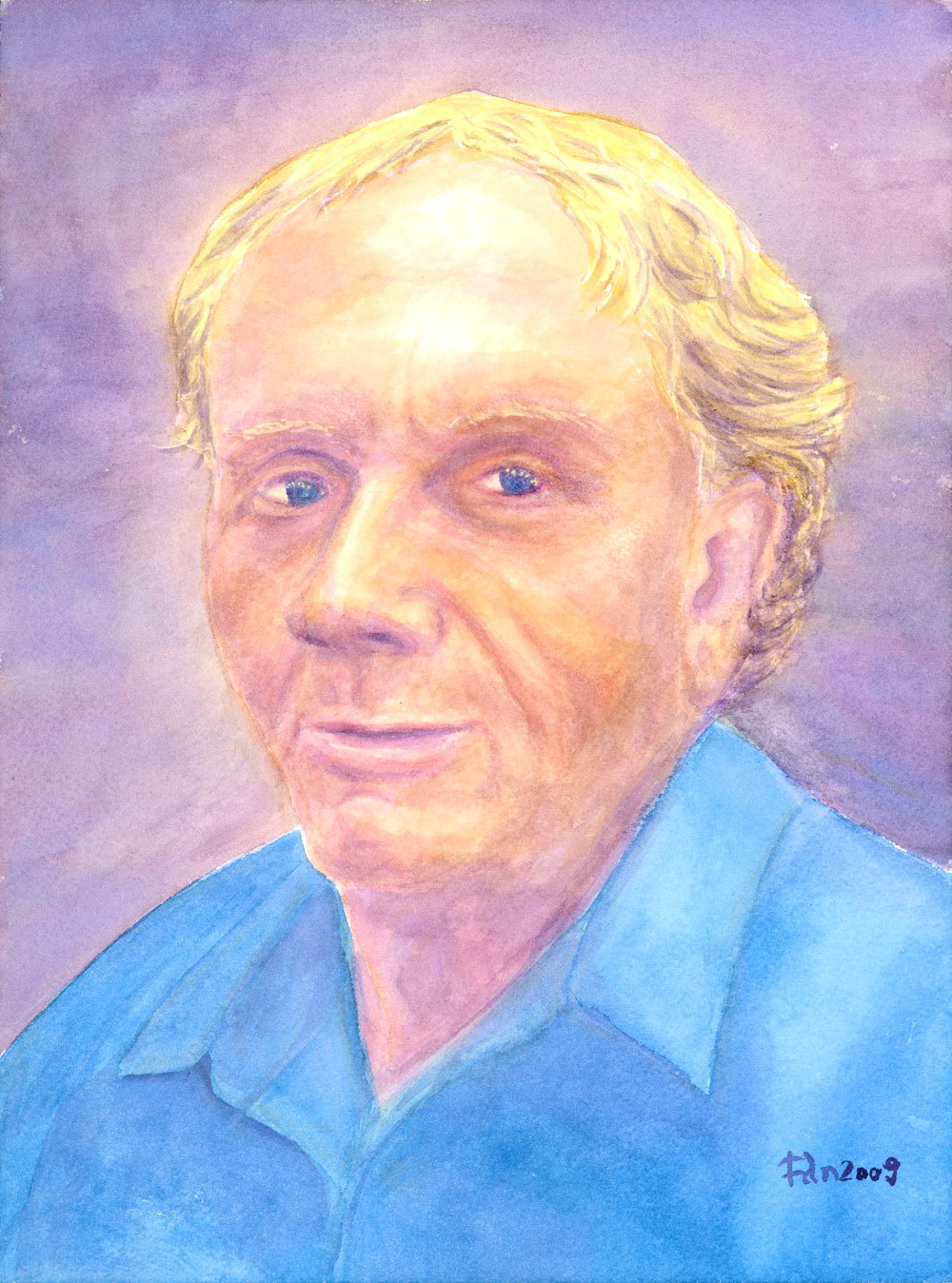
The ultimate juggler
A portrait of Ronald Graham
(March 15, 2009)
|
Martin Gardner
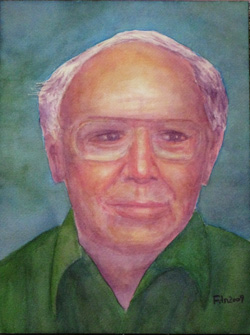
A portrait of Martin Gardner
(July 15, 2009)
|
Martin Gardner was one of the most admired and influential figures in mathematics, well known for his numeous books and columns on math recreation.
I remembered a visit with Ron to Martin's house in Carolina in the 1980's, particularly his basement filled with math correspondence and references. During this visit,
I found out that Martin did not think of himself as a mathematician.
That was one of the main reasons that he explained so well and wrote so beautifully.
To our amazment, inspite of all his writing, Martin had never published any research papers
in mathematics at that time. Our visit was
the start of a joint work with Martin which later appeared in Math Magazine in 1989,
titled,
Steiner trees on a checkboard.
I wrote the first draft of paper which was then sent to Martin for his comment. He wrote back saying " I couldn't find a single word to change."
That was the highest complement that I have ever received, especially from an accomplished writer like Martin. The paper was later awarded the
Allendoerfer Award by Mathematical Association of America in 1990.
It is worth mentioning that
it is not unusual that (junior) one of the coauthors took up the job of writing
and this joint paper with Martin was actually entirely written by myself.
What I found so amazing about this paper was the kind and generous note from Martin.
I consider this to be the highest praise about my writing ever!
Here is the
Interview with
Martin Gardner in Notices of AMS.
|
 (This page is still under construction.)
(This page is still under construction.)
















 (This page is still under construction.)
(This page is still under construction.)